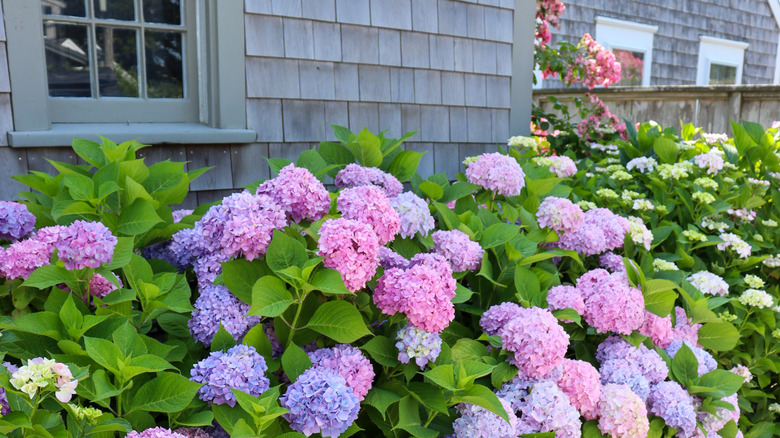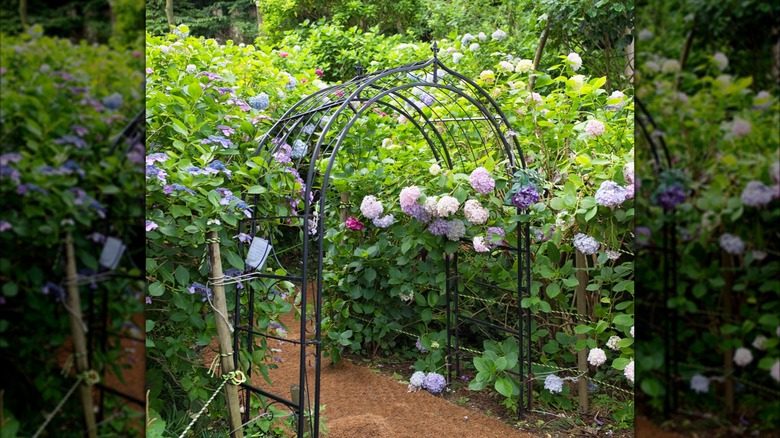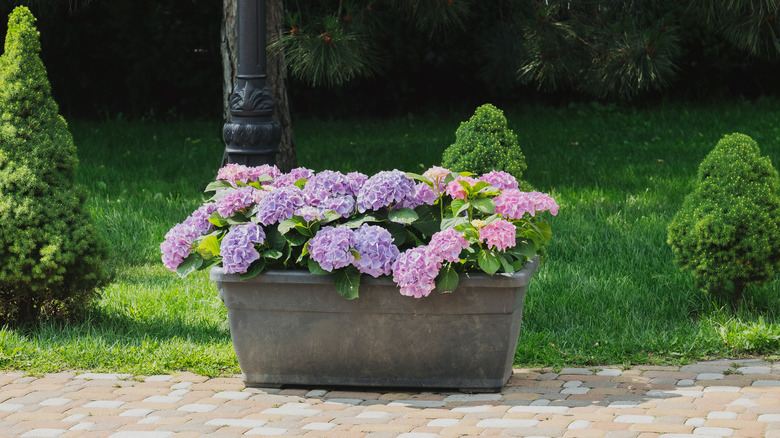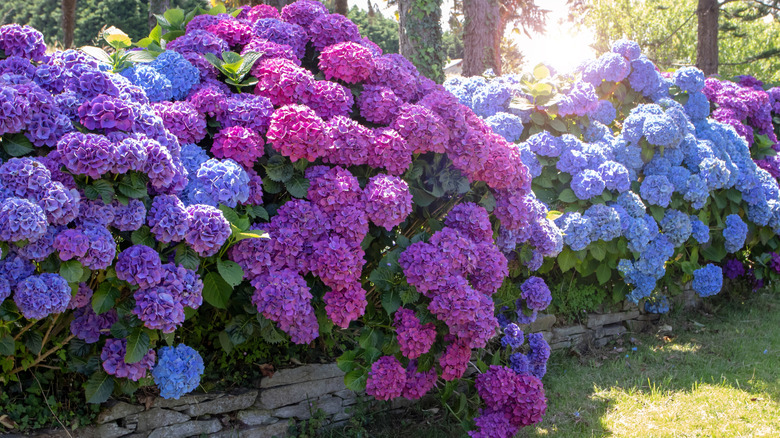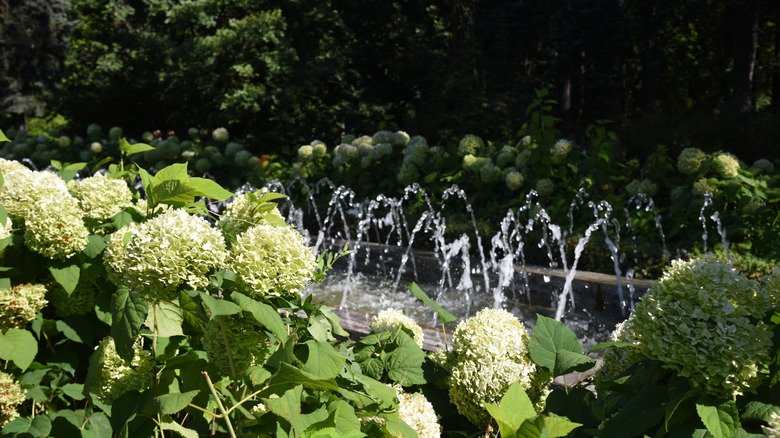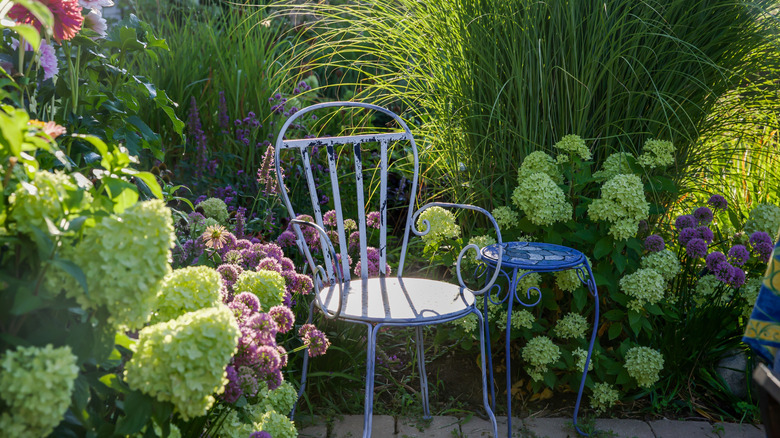22 Hydrangea Garden Ideas To Inspire Your Next Outdoor Project
We may receive a commission on purchases made from links.
Hydrangeas (Hydrangea spp.) have a way of making gardens and landscape design feel instantly welcoming, thoughtfully composed, and even fairy tale-like — no matter the context. Their fluffy blooms, whether in crisp white, vivid summery blue, or muted pastel pink, create a sense of soft wonder and romance that few other flowers or shrubs rival. When planted in pairs or larger groups, hydrangeas form beautiful clusters of colorful blossoms, framing pathways with wonder, anchoring beds with a visual focal point, or softening the stark edges of lawns. Part of their charm is their versatility. They can make a space feel instantly like an English cottage, Nantucket seaside escape, or sprawling country house.
Growing and taking care of hydrangeas isn't terribly complicated either. Most varieties thrive in sun or partial shade, and they all love consistent moisture, especially throughout the summer. Most hydrangeas are woody, deciduous plants that prefer loamy soil. They bloom from summer to fall, depending on the species or cultivar. Generally hardy in Zones 3 to 9, these shrubs average 2 feet tall, with some, like panicle hydrangeas (Hydrangea paniculata), reaching heights of up to 20 feet and spreads of up to 8 feet. Given how diverse hydrangeas can be, we have no doubt that whatever your garden dreams are, there's a way to achieve them with these stunning shrubs.
Frame out your lawn in a small yard with hydrangeas
Live in suburban sprawl with not much yard space? Planting hydrangeas along the edge of a lawn will transform your small, cookie-cutter garden into a seemingly bright, expansive backyard oasis. Their bushiness anchors the lawn to the yard, making your design feel more intentional, complete, and larger than the blueprint you inherited from builders. Consider vibrant green-blooming cultivars like the 'Limelight' panicle hydrangea (Hydrangea paniculata 'Limelight') or a classic white-flowering smooth hydrangea (Hydrangea arborescens 'Annabelle').
Hug the house with hydrangea blooms
Hydrangeas lend a softening hand to many architectural elements. Planting them close to your house creates a natural transition between it and the garden. Their pillowy blossoms make the geometric lines of a house fade into its surroundings elegantly. When the shrubs bloom, the colors instantly brighten the facade of the house as well. On a practical level, planting hydrangeas right next to the house provides a natural windbreak for the shrub, protecting it from high winds and maintaining soil moisture, both of which help facilitate growth.
Add a hydrangea-filled arch to your garden
Speaking of mixing architectural elements with the soft, natural look of hydrangea shrubs, add an archway among the blooms. It creates a romantic focal point in your garden. Arches can give hydrangea-filled backyards layered depth, with blooms growing above, below, and alongside the hardscaping. You'll frame the perfect photo spot in your yard. Whether left unadorned to let the arch do the talking or dressed up with fairy lights or climbing vines, arches and hydrangeas create the ultimate cottagecore look.
Grow hydrangeas in planters
Growing hydrangeas in planters is a beautiful and practical choice for your garden. Aesthetically, planters allow you to craft purposeful moments. Curate the look with carefully chosen containers in different materials, colors, and textures that complement your home's style. On the practical side, growing hydrangeas in planters lets you better control the soil (and hence the acidity and color of the flower — more on that later), moisture, and light exposure with precision. You can also move your potted hydrangeas around the yard to address environmental concerns or dress up an area when you're hosting outdoors.
Grow hydrangea bushes alongside fences
Everything about growing hydrangeas alongside a white, picket fence screams a charming, New England seaside cottage. Maybe it's the contrast between the bright clusters of blossoms and the vertical lines of a fence. Perhaps it's the bushes framing out a garden to make it feel like an invitation into a secret garden. Either way, hydrangeas benefit from the partial shade that some fences provide, especially during hot summer afternoons. Planting them alongside fences is also a particularly good idea for taller varieties that are prone to flopping over.
Line stairways with hydrangeas
If your garden features a staircase that feels a little too manufactured, use hydrangeas to soften its hard edges. It will make the stairway feel like a part of the garden. Hydrangeas' lushness and vibrancy add color and texture to an otherwise inorganic-looking set of stairs. During the late spring to early fall, when the flowers are in bloom (depending on the species or cultivar), it'll feel like you're descending into a flower tunnel. Taller shrubs can also provide a bit of subtle, tasteful privacy if you don't want neighbors seeing you in your garden.
Dress up your driveway with hydrangeas
Hydrangeas are an inviting sight, and planting them alongside driveways and roads creates a picturesque residential entrance that feels natural yet elegant. As with lining stairways, taller hydrangeas act as a privacy hedge without feeling claustrophobic for you or your visitors. Since they are deciduous plants, the seasonal changes in bloom color — depending on species or cultivar — also create some visual dynamism. Overall, hydrangeas planted along a driveway enhance curb appeal, extending the vibrancy of the garden into a typically functional space.
Use hydrangeas to border your garden paths
Bordering garden paths with hydrangeas adds charm, color, and a sense of direction to outdoor spaces. The shrubs encourage people to stroll through the area, following their blooms. Hydrangeas dress up the edges of pathways by contrasting with the stark paving materials. The path feels gentler and more inviting with visual interest along the route. Taller hydrangea shrubs can act as a privacy hedge. They can also cast some much-needed shade in the garden when you go for your daily summer strolls.
Mix and match hydrangea bloom colors
Here's where we want to nerd out about the dynamic, scientific explanations for hydrangea colors. Broadly speaking, hydrangeas grown in more alkaline soils will have redder or pinker blooms, while the flowers on shrubs planted in more acidic soils will be bluer. Gardeners can mix and match flower colors by manipulating soil contents — adjusting the pH of the soil — with acidic additives. Don't be afraid to play with different colors to create fun combinations or a visually striking garden.
Go monochromatic with your hydrangeas
You can also manipulate the soil your hydrangeas grow in to ensure they bloom the same color for a monochromatic look. For instance, if you enjoy the look of all blue flowers, there are ways to make your soil more acidic with additives like elemental sulfur, vinegar, or lemon juice. Bear in mind, though, that only certain types of hydrangea boast flower color-changing tendencies. If you want to control your garden palette in this way, opt for bigleaf hydrangeas (Hydrangea macrophylla) or mountain hydrangeas (Hydrangea serrata) — the former has the most dramatic color change.
Choose classic white hydrangeas
White hydrangeas are mostly color-stable, meaning the blooms will stay white or cream throughout the seasons and despite soil manipulation. If you want to lean into a crisp, neutral palette that matches with any and all neighboring plants or the style of your house, then choose smooth hydrangea cultivars like 'Annabelle' or 'Incrediball.' Expect some minor color progression as the seasons change. White hydrangeas typically start out a little yellowish-green, progressing to that powdery white, then ending with a warm, antiqued cream. However, for the most part, they'll stay light in hue.
Layer hydrangeas with other flowers
Like many other flowering shrubs, hydrangeas thrive with companion plants. Layering them with other blooming plants not only creates texture in your garden but it can help your hydrangeas grow better than if they were alone. Some of the best plants to grow next to hydrangeas for a thriving garden include low-growing perennials or annuals, like creeping phlox (Phlox subulata), to provide a colorful and whimsical foreground to the shrubs. Behind hydrangeas, think taller, vertical flowering plants, such as hollyhocks (Alcea rosea), to add height and visual contrast.
Grow hydrangeas under windows
Growing hydrangeas under windows is the perfect way to frame these focal points of your home, especially curbside. It boosts curb appeal, and from the inside, you can enjoy the color and texture of the hydrangeas up close. When caring for hydrangeas planted close to your windows, remember that deadheading old flowers is key. It ensures your hydrangeas get the healthy airflow they need to thrive in these tight spots. Plus, you don't want those big blooms to block the light to your windows. When done correctly, planting hydrangeas under your windows feels intentionally elegant.
Add sculptures among hydrangea bushes
Much like the earlier arch idea, adding sculptures to a hydrangea patch gives your garden an artsy edge. Because hydrangea shrubs provide such copious amounts of vibrant green leaves and rounded blooms, they offer the perfect backdrop for art made from a contrasting material, like stone, metal, or ceramic. These objects pop against bright florals, drawing the eye. Adding some sculptures in the garden introduces textural interest, height, and personality, keeping your hydrangeas interesting even when they're not in bloom. For traditional English gardens, consider woodland animal statues. For Japanese Zen gardens, opt for pagodas.
Pack hillsides with hydrangeas
Even if your property is mostly hills, that doesn't mean you can't transform your slopes with a flood of hydrangea shrubs. Since hydrangea leaves and flowers are so broad, these plants add lots of coverage, helping a hillside look purposefully curated rather than an underused or empty plot. Slopes are also great planting spots for hydrangeas because they drain well, reducing the risk of soggy roots. Healthy hydrangea roots can also help prevent erosion on a hillside, making these vibrant shrubs a practical and magical choice for slopes.
Plant hydrangeas alongside water features
For those hoping to achieve a full-on fairy tale aesthetic with hydrangeas, think about planting them around a water feature. Whether they're framing an existing pond or bordering the brook running through your property, flowering hydrangeas add color and drama to water features. You'll elevate a natural area into something that feels purposefully curated. Don't fret if you don't have direct access to wild water features, though. Nowadays, there are plenty of freestanding water fountains with pumps that are simple to install and maintain. Try the 48-inch tall Watnature Zen Three-Tiered Pagoda Outdoor Fountain.
Add bistro seating or benches to a hydrangea patch
Adding seating to hydrangea bushes, whether with a bistro set or a bench, gives you a peaceful spot to enjoy the beauty of your garden up close. The tall shrubs form a natural enclosure, creating a quaint nook or retreat that doesn't feel too confined. It's a place in which you can read, rest, or simply savor the views of your garden. You'll be enveloped in a natural world of your own making. This type of hardscaping provides more than simple practicality; it helps you create a calm, focused garden.
Frame a pergola path with hydrangeas
When thinking about hardscaping, large features like pergolas often spring to mind. It's no wonder these structures are focal points of a garden. However, pergolas can be domineering in a garden. Soften them by planting hydrangeas alongside them. Pergolas are beneficial for hydrangeas, too, providing shelter from heavy rain or snow during colder months. Just remember that hydrangeas enjoy full sun for several hours a day, so whatever you plant to climb the pergola should not block the sun.
Layer hydrangeas with ornamental trees
Plant your hydrangeas in layers with ornamental trees to create visual interest. This is the same concept as layering your hydrangea beds with other companion plants, just on a larger scale. Ornamental trees are great for creating garden backdrops or hedges. Plant hydrangeas — with their bushy growth and oversized flowers — in front to reduce the severity of the trees and brighten their sometimes dull green aesthetic. Don't plant your hydrangeas too close to your trees (or vice versa) because they will compete for water and nutrients. Both are heavy feeders.
Tuck hydrangeas between trees for a flower-filled oasis
If your yard is wooded with large gaps between the trees, consider filling those spots with hydrangeas. While hydrangeas should not be planted directly below large trees (they will compete with each other for resources), crafting beds tucked between the trees can create a lovely, layered look. Your hydrangeas need plenty of sunlight, decent partial shade, and good moisture in order to survive among the trees. If you're willing to commit to their care, you can create beautiful pockets of blooms.
Embrace the ombre of hydrangea blooms
Panicle hydrangeas (Hydrangea paniculata) are known for their characteristic ice cream cone-shaped clusters and showy color gradients as the growing season progresses. While the flowers start out a greenish-white, they progress into sherbet pinks and cherry reds in an ombre fashion. This natural color change makes these hydrangeas a fantastic choice for an indecisive gardener. You get to enjoy classic white flowers and more vibrant hues on the same plant. Cultivars like 'Pinky Winky Prime' and 'Quick Fire Fab' are well-known for their gradient color changes.
Create fairy tale vibes with a climbing hydrangea
A unique hydrangea that'll inspire anyone with a penchant for cottagecore or fairy tale garden aesthetics is the climbing hydrangea (Hydrangea petiolaris). It has lacier, more delicate flowers than its shrubby cousins. But what it lacks in dense clusters, it makes up for with climbing. This hydrangea species is a great choice for sturdy garden structures like brick or concrete walls. These easy-to-maintain plants can grow up to 50 feet long and 6 feet wide, making it a good alternative to English ivy. Its root systems aren't anywhere near as invasive.


